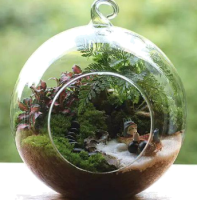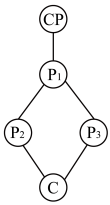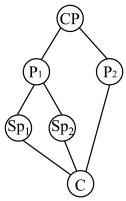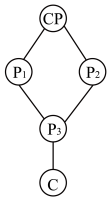1 . As a botanists who studies our cultural relationship with plants, I am forever fascinated with what draws people to gardening.
Admittedly, connecting with the natural world might seem like an obvious motivation, and undoubtedly it is a key part of the attraction.
As I work on my tiny terrariums (玻璃花园) on dark February nights, something magical happens to my brain.

As our world becomes more and more unpredictable and often frightening, gardening seems to be able to appeal to and reach out to a whole new generation, often against all odds.
Of course, gardening in’ t the only thing people turn to. The rise of culture conflicts and fix at ion on body image have also been widely documented as being driven by a psychological need to feel a degree of certainty, control and safety. However, I can’t help but think of these alternatives:
| A.In reality gardens are anything but natural. |
| B.What are the things they have been attracted to? |
| C.They are idealized landscape with all the mud, pests and dead plants edited out. |
| D.How much better a place the planet would be if gardening was our outlet for this need! |
| E.Much like agriculture, gardening is a universal human desire coded into our cultural DNA. |
| F.The calmness created by owning a tiny green space under my control has a powerful effect on my mind. |
A plan to restore green spaces
The UK government has revealed a plan to protect and restore England’s wild life. It focuses on at-risk species by making canals, rivers and streams cleaner and expanding green spaces.
The new Environmental Improvement Plan sets goals to create or restore more than 5,000 square kilometres of wildlife habitats across England and restore 400 miles of rivers. It will create or expand 25 national nature reserves. New woodland will also be planted alongside rivers. At the moment, access to green spaces is not equal across the UK. Around 4% of people live more than 10 minutes away from their nearest park. The Environmental Improvement Plan aims to make sure households in England are within a 15-minute walk to a green space.
As well as helping more people to act close to nature, the plan should increase England’s biodiversity. A species Survival Fund will be set up to help some of England’s most endangered animals, such as red squirrels (松鼠) and watch rats. The Government has set targets to boost these species by 2030. There are also targets to reduce food waste, glass, metal, paper and plastic by 2028, and to improve the quality of water in rivers.
New rules mean that the Government will have to consider the environmental effects of any policy it puts forward. These goals are part of a 25- year plan that was launched in 2018. The aim of the plan is to improve the environment “within a generation ” which is roughly 25 years.
Although lots of people have welcomed the plan, not everyone is impressed. Pail de Zylva, from the charity Friends of the Earth, said it wasn’t clear enough how the goals would be met and that many of them were like promises the Government had already made but not yet delivered.
________________________________________________________________________________________________________________________________________________________________________________________________________________________________________________________________________________________________________________________________________________________________________________________________________________________________________________________________________
“In wilderness(荒野) is the preservation of the world.” This is a famous saying from a writer regarded as one of the fathers of environmentalism. The frequency with which it is borrowed mirrors a heated debate on environmental protection: whether to place wilderness at the heart of what is to be preserved.
As John Sauven of Greenpeace UK points out, there is a strong appeal in images of the wild, the untouched; more than anything else, they speak of the nature that many people value most dearly. The urge to leave the subject of such images untouched is strong, and the danger exploitation(开发) brings to such landscapes(景观) is real. Some of these wildernesses also perform functions that humans need—the rainforests, for example, store carbon in vast quantities. To Mr.Sauven, these ”ecosystem services” far outweigh the gains from exploitation.
Lee Lane, a visiting fellow at the Hudson Institute, takes the opposing view. He acknowledges that wildernesses do provide useful services, such as water conservation. But that is not, he argues, a reason to avoid all human presence, or indeed commercial and industrial exploitation. There are ever more people on the Earth, and they reasonably and rightfully want to have better lives, rather than merely struggle for survival. While the ways of using resources have improved, there is still a growing need for raw materials, and some wildernesses contain them in abundance. If they can be tapped without reducing the services those wildernesses provide, the argument goes, there is no further reason not to do so. Being untouched is not, in itself, a characteristic worth valuing above all others.
I look forwards to seeing these views taken further, and to their being challenged by the other participants. One challenge that suggests itself to me is that both cases need to take on the question of spiritual value a little more directly. And there is a practical question as to whether wildernesses can be exploited without harm.
This is a topic that calls for not only free expression of feelings, but also the guidance of reason. What position wilderness should enjoy in the preservation of the world obviously deserves much more serious thinking.
1. John Sauven holds that_____.
| A.many people value nature too much |
| B.exploitation of wildernesses is harmful |
| C.wildernesses provide humans with necessities |
| D.the urge to develop the ecosystem services is strong |
| A.The exploitation is necessary for the poor people. |
| B.Wildernesses cannot guarantee better use of raw materials. |
| C.Useful services of wildernesses are not the reason for no exploitation. |
| D.All the characteristics concerning the exploitation should be treated equally. |
| A.Objective. | B.Disapproving. | C.Sceptical. | D.Optimistic. |
CP: Central Point P: Point Sp: Sub-point(次要点) : Conclusion
A. | B. | C. | D. |
The problem of electronic waste
We have gradually come to realise that in two ways in particular, modern hi-tech can be bad for the planet. The first is its energy use; the worldwide scale of information technology is so enormous that electronics now produce fully two percent of global carbon emissions, which is about the same as the highly controversial emissions of aeroplanes. The other is the hardware, when it comes to the end of its natural life. This, increasingly, is pretty short. We have hardly noticed this important stream of waste, so much so that a Greenpeace report on the untraced and unreported e-waste two years ago referred to it as “the hidden flow”. We need to be aware of it.
The latest United Nations Environment Programme (UNEP) report estimates that worldwide, electronic waste is mounting by about 40 million tons a year. So what can we do about it?
The European Union has recognised the problem by adopting a key principle: producer responsibility. In other words, making it the duty of manufacturers of electronic goods to ensure their safe disposal at the end of their lives. In practice, an EU regulation now means that electronics dealers must either take back the equipment they sold you, or help to finance a network of drop-off points, such as public recycling sites. Its main feature is quite ambitious: it aims to deal with “everything with a plug”.
The new UN report suggests that all countries could do something about the problem with a change in design. Groups such as Greenpeace have led the way in putting pressure on major manufacturing companies to find substitutes for the toxic chemicals inside their products. Encouragingly, they have had some success in forcing them to develop non-poisonous alternatives to these. This may be the real way forward.
___________________________________________________________________________________________________________________________________________________________________________________________________________________________________________________________________________________________________________________________________________________________________________________________________________
Wildlife Report Calls for Action
The World Wide Fund for Nature released its Living Planet Report, which found that the Earth’s wildlife populations have fallen by 69% in the past 50 years.
The report is produced every two years to show how the natural world is changing, so governments, businesses, and conservationists understand
The change in wildlife varies around the world. South America and the Caribbean are the most affected. In these areas, the average wildlife populations have dropped by 94% over 50 years. Central Asia and Europe have
While some news from the Living Planet Report is worrisome, there is good news, too. Up to now the numbers of many species
In the US, conservation efforts in recent decades have helped to save several species, including the bald eagle, which
6 . Chemists in mid-1500s Nuremburg had discovered that bird droppings were a rich source of saltpetre, a vital ingredient in the making of gunpowder. As a consequence pigeon droppings used to be almost as valuable as silver. Understandably, by the middle of the following century, there were an estimated 26,000 pigeon houses in Britain.
The practice of keeping the pigeon was introduced to Britain by the Romans. The Normans kept pigeons in specially constructed niches in castles and courtyards. When the pigeon houses in Britain were built, they were a vital source of meat and feathers. The latter were particularly prized as a source of warmth. Droppings gathered from the pigeon houses was a rich fertilizer, too.
The pigeon house was not only a source of food and revenue in medieval times, but also a status symbol. The privilege of building or owning pigeon houses was reserved for the rich. Towards the end of her rule, Queen Elizabeth I decided to open pigeon-breeding to the free market. Then, pigeon houses sprang up all over the countryside.
The number of pigeon houses across the British countryside was not universally welcomed. Each day the birds flew off to feed themselves on other people’s crops. By the middle of the 17th century, the problem of pigeons was so great that people feared that the destructive pigeons would turn England into a desert.
Luckily, an agricultural revolutionary, Charles Townsend, had introduced the turnip to Britain around 1700, keeping farm livestock fat enough to eat through the dark winter months. Later, vast quantities of natural saltpetre were discovered in Chile and California. Keeping pigeons went out of fashion.
Now, the homeless pigeons flew off to find somewhere else to live. One species discovered that Britain’s rapidly growing towns and cities were full of the sort of rock-faces they liked to rest on—humans called them “buildings”. Over time they’d become the wild urban pigeon that we know today.
1. Which of the following people in Britain would be least likely to keep pigeons in the late Middle Ages?| A.Fruit growers. | B.The nobles. | C.Gunpowder makers. | D.The miners. |
| A.Farm livestock used to be too thin for lack of food in the dark months in Britain. |
| B.Townsend revolutionized agricultural development in Britain around 1700. |
| C.The Normans set an undesirable example of raising pigeons for the British people. |
| D.England was once faced with the threat of disappearance because of pigeons. |
| A.Because people think it a sign of status and keep them to show off. |
| B.Because pigeons like to stay on hard surfaces which can be abundantly found in cities. |
| C.Because pigeons find enough food supplies when tourists and citizens feed them in squares. |
| D.Because the government encourages pigeon raising as a profitable investment. |
| A.A brief history of pigeon houses in Britain. |
| B.From function to fashion — the pigeon houses in Britain. |
| C.Profitable pigeon houses in Britain. |
| D.Pigeon houses in Britain as valuable as silver. |
7 . French adventurer-scientist Roland Bourdeix has a grand vision for how to preserve a thousand or more genetic varieties of coconut trees. Imagine, as he does, turning dozens or hundreds of remote Pacific islands into coconut sanctuaries. Each island would contain just a few varieties of these trees.
But why? Are coconut trees, the source of oil and newly trendy coconut water, somehow in danger?
Not exactly. At least not for now. There are plenty of coconut palms all over the tropics, and coconut production has been slowly growing. But that masks a potential long-term problem, says Stephan Weise, Deputy Director General for Research at Bioversity International in Rome. Most coconut production comes from a small part of the coconut’s gene pool (基因库). Producers rely on a handful of high-producing varieties or hybrids (杂交品种). Those commercial varieties are slowly overwhelming (压倒)traditional varieties that people in the tropics have grown thousands of years. Those are the storehouse of the coconut’s genetic diversity: All of the colors, shapes, tastes, and survival tools that this species possesses — and may need again someday.
Conserving (保护)such diversity in agricultural crops is a familiar problem, but the situation with coconuts is a little bit different, Weise says.
First of all, scientists can’t yet preserve a particular kind of coconuts in refrigerated “gene banks,” as they do with standard seeds. They can’t dry, freeze, and preserve coconuts for decades. Instead, coconuts have to be preserved as living trees, growing outside.
This leads to the second problem. Coconut varieties growing in the open air often won’t reproduce themselves successfully. Their flowers pick up pollen (花粉)from other trees nearby, which often turn out to be commercial varieties or hybrids. And when that happens, some genes may be lost altogether.
So what’s the secret to preserving these coconuts? For starters, scientists have set up a dozen open-air coconut gene banks. They’re reproducing each variety through careful hand-pollination of the trees. But Weise says that’s expensive and labor-intensive.
This brings us back to Roland Bourdeix’s crazy-sounding idea. The key to preserving coconut biodiversity more cheaply, he thinks, is isolation. And there’s no more isolated place than a lonely Pacific island. Just convince people on one of these islands to plant coconut trees from a single variety, and the problem is practically solved. He’s found several islands where the inhabitants are willing to help turn his vision into reality. One of them is well-known already: The Tetiaroa Atoll in French Polynesia, an idyllic retreat once owned by Marlon Brando.
1. Why is it important to preserve the traditional varieties of coconut?| A.The traditional varieties are more commercial. |
| B.They can help explain the history of people living in the tropics. |
| C.They contain genetic diversity. |
| D.It can help the tourism on remote Pacific islands. |
| A.They freeze them. | B.They hand-pollinate them. |
| C.They grow them out of labs. | D.They mix them with other breeds. |
| A.They are owned by celebrities, which can help promote public awareness of the issue. |
| B.They are among the most isolated places in the world. |
| C.The inhabitants on the islands are innocent enough to be deceived. |
| D.The labor on those islands is cheaper. |
| A.A Crazy Gardener |
| B.Remote Islands for Preserving Coconut Genes |
| C.Advantages of Traditional Coconut Trees |
| D.Loss of Coconut Genes |
8 . Hailing from Sweden, “plogging” is a fitness craze that sees participants pick up plastic litter while jogging adding a virtuous, environmentally driven element to the sport. Plogging appears to have started around 2016, but is now going global, due to increasing awareness and
The appeal of plogging is its
Running and good causes have always gone
Anything that’s getting people out in nature and connecting
We need to keep momentum high and the pressure up, and empower people through
The plastic Patrol app allows users to
Plogging isn’t the first fitness trend to combine running with a good cause, Here are some of our favourites:
Good Gym
Its idea is simple: go for a run, visit an elderly person, have a chat and some tea, and run back.
Guide Running
Guide runners volunteer their time to helping blind people get
Start-up Stuart Delivery and the Church Housing Trust collaborated last year in bringing clothing and healthy food to the homeless. Deliveries are mostly made by bike, so those who deliver keep fit while helping rough sleepers(无家可归者).
1.| A.satisfaction | B.hesitation | C.fear | D.control |
| A.complexity | B.simplicity | C.instrument | D.expense |
| A.substance | B.responsibility | C.value | D.weight |
| A.one on one | B.head to toe | C.hand in hand | D.on and off |
| A.positively | B.neutrally | C.objectively | D.fairly |
| A.accuse | B.rid | C.assure | D.rob |
| A.shift | B.interest | C.aid | D.delight |
| A.motives | B.performances | C.exercises | D.initiatives |
| A.eliminate | B.map | C.seek | D.degrade |
| A.leading | B.devoting | C.ending | D.uploading |
| A.Disappointment | B.Tiredness | C.Sickness | D.Loneliness |
| A.therefore | B.moreover | C.however | D.instead |
| A.excited | B.ready | C.active | D.smart |
| A.visually | B.audibly | C.visibly | D.sensibly |
| A.Running | B.Plogging | C.Driving | D.Cycling |
| A.Feed the dog | B.Clean the dog’s house |
| C.Give the dog a bath | D.Find something to eat. |
The illegal ivory trade (象牙贸易) has been a major problem in Africa for decades. Poachers (偷猎者) and hunters have killed hundreds of thousands of elephants to obtain this precious material. Now the areas in which they do it are taking action. The International Union for Conservation (保护) of Nature (IUCN) announced on Dec 3 that key states
Recently, top officials and experts from 30 states met to discuss how to protect Africa elephants. The conference,
In
According to the IUCN, 2011 saw the highest levels of poaching and illegal ivory trading in at least 16 years. Around 25,000 elephants were killed in Africa that year. “With an estimated 22,000 elephants illegally
At the meeting, key Africa states where elephants make



